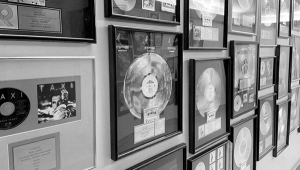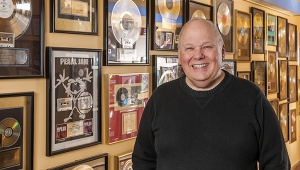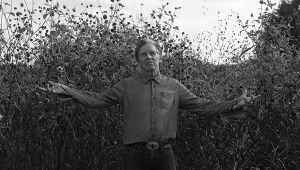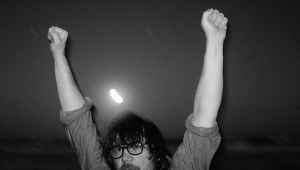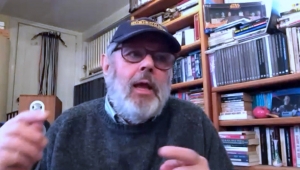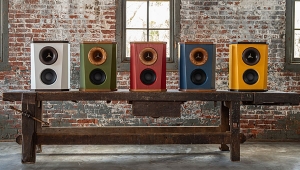| Columns Retired Columns & Blogs |
Russellmania: Bryston & the Brothers Russell
Although the term "professional" is often used as part of model designations in consumer electronics, the actual overlap between the audiophile consumer market and the real pro market is quite small. There are speakers in common use as studio monitors that no self-respecting audiophile would want to be caught dead listening to, and the typical audiophile loudspeaker would go up in smoke if asked to pump out the kind of volume that pro application routinely demands. To a lesser extent, the same applies to amplifiers: pro is pro and consumer is consumer, and ne'er the twain shall meet.
Except for Bryston, Ltd. In the past 20 years this Canadian company has been almost unique in being equally successful in marketing their products to professionals and audiophiles. Their amplifiers are used by recording and broadcast studios, clubs, and a major movie-theater chain. Their products have also done well with audiophiles, earning positive reviews from magazines like Stereophile. (See Larry Greenhill's review of the Bryston 3B-ST, 7B-ST, and BP-25 elsewhere in this issue.)
To get the scoop on the secret of Bryston's success, I visited their factory in Peterborough, Ontario (about an hour's drive from Toronto), and talked to Brian Russell (President), Chris Russell (Vice President, Engineering), James Tanner (Vice President, Sales), and Stuart Taylor (the engineer responsible for the latest Bryston amplifiers, designated, not coincidentally, the "ST Series"). I asked them how the company had got started:
Chris Russell: It was started in 1962 by three men whose names are incorporated into the company name: Tony Bower, was the "B," a guy named Stan Rybb, was the "ry," and a fellow named John Stoneborough was where the "ston" comes from. They were making medical equipment and industrial electronics. My father had been a NASA engineer and was involved in the large NASA layoff in the late 1960s when the Apollo missions were terminated. He bought Bryston, Ltd. in late '67...and that was my first job out of college. I started thinking about what would interest me, and sound equipment is what immediately came to mind. I started learning as much as I could about it.
Robert Deutsch: You were a fledgling audiophile?
Chris Russell: I've been an audiophile all my life. I've always loved good sound systems and accurate portrayal of music.
Deutsch: What was your first audio product?
Chris Russell: The first product we made was an amplifier we called the Pro 3, which was in 1973. I took a prototype of it to Eastern Sound, a recording studio. Interestingly enough, at that time the engineer in charge of sound equipment at Eastern Sound was Stuart Taylor. They did a number of listening tests, and, somewhat to my surprise, they said they really liked the prototype and ordered two of them. The prototype was just in a utility box, so I figured we'd better get started on designing this thing for sale. It took a few months.
Deutsch: So your first consumer product was probably the 3B?
Chris Russell: Yes. The Pro 3 was called that because the first customers were professional sound studios. Very soon after that we started exploring the market, including the audiophile industry. So we took it to some stores in Toronto, and my brother John loaded a few of them in the back of his Honda and drove down to the States and got some dealers interested there. And things have expanded from there.
The 4B was the very next piece. The first one that got made I put together myself, having never [even] breadboarded the thing—I just laid out the circuit boards with a circuit that I sort of had in my mind and never even put on paper. The pieces all came in and we put them together, and, believe it or not, it actually worked the first time. It went into production in 1976 and [has] stayed in production ever since. Of course, we've made continuing changes and improvements.
Deutsch: When you design a product, do you have an ideal that you aspire to?
Chris Russell: I think the real crucial issue to us is accuracy. What we're looking for is a product that takes an input signal and transforms it in whatever way that product is called upon to do—in the case of an amplifier, for example, to make it bigger in both voltage and current and to change it in no other way; to change the frequency response as little as possible, to restrict the dynamic range as little as possible, to add harmonics to a degree that's almost immeasurable with the best equipment available. When we can do that and can take it home and can actually hear that it's performing in a way that we want it to in terms of accurately rendering the music, then we call it a successful product. We're also concerned with reliability and value.
Deutsch: What would be a typical design process, from conception to execution?
Stuart Taylor: I've designed several new products for this company, starting with a Dolby system for Nagra analog tape recorders, which we still sell. That was actually brought to us by an outside party who wanted to have it built, and I designed it.
Brian Russell: There would normally be a number of discussions over time—from three days to three years—about what a particular product has to do and what the industry is looking for. We ask a number of dealers and investigate other products to see what they offer in terms of features. Then we sit around and discuss what features we want to put on it. We tell the engineering department, "This is what we need." They then say, "If we do that, we can do this, too." Eventually, over a period of time, it evolves into a workable design. Then the sales department typically starts asking the engineering department every day if it's been done yet. That goes on for six or seven months. Then we get a prototype, then listening samples, and then production samples.
Deutsch: Do you send any pre-production prototypes to people such as dealers, asking them for feedback?
Brian Russell: No, we don't do that. Usually, Jim and Chris take the product home and listen to it for quite a while.
Chris Russell: There's an interesting story about how the model 8B came about. It was first designed by a different engineer than Stuart Taylor. Essentially, what we wanted to do was to combine two 3Bs into one box. We ran into problems with the four separate power supplies...We ended up with a product that had performance approximately equivalent to a pair of 3Bs. About the time that we were literally ready to go into production, Stuart and I sat down and were conferring about it, and to some extent we were disappointed that we hadn't made any forward strides. Stuart hadn't been involved in the design but had been involved in a lot of the testing. Somehow it wasn't enough to bring this product to the market, simply saying it's two 3Bs in one box.
Deutsch: Was the nature of your dissatisfaction with the technical performance, the lack of elegance in the design, or the sound quality?
Chris Russell: It was fraught with compromises.
Taylor: We had all sorts of problems getting the four power supplies to work together in close proximity with one another without causing all sorts of interference. It seemed to me that the amount of fiddling we had to do to make it work was going to be a nightmare down the road. I wanted to find some other way to do it that would clean the whole thing up.
Chris Russell: So Stuart asked if he could put his two cents' worth into this product.
Deutsch: You do pay him more than two cents, don't you?
Chris Russell: Actually, three. But he had to ask for the two cents first. [laughs]
Taylor: I suggested a few things that might reduce these problems.
Chris Russell: By that time, the engineer responsible for the design had left the company, so I asked Stuart if he wanted to take the project over. He agreed and asked how far he could go in redesigning the product. And I said, "Anything you want to do that would result in a product that would be a big step forward." I was dismayed to see him almost literally rip up the set of blueprints, including the chassis and the power-supply layout. He threw everything away and started from scratch. It took about six months to bring the product to the position that Stuart was happy with, and he came up with something that was quite a bit better—significantly lower noise and lower distortion—than what we had previously.
Deutsch: Can you hear these improvements with source materials and other associated electronics that don't have super-low noise levels themselves?
Chris Russell: The new digital formats have extremely low noise levels.
Deutsch: But how about the more traditional sources?
Chris Russell: The quick answer is that the better the source and the better the ancillary equipment, the more you'll hear the differences. But, interestingly enough, the first time I became really aware of the improvement in the new ST Series amplifier was when I was called to give a presentation at an Audiophile Society meeting in New York. I took the new 8B and the new BP-20 preamp, having not had much time to sit down and listen to them in my own home. We hooked them up to a sound system that I had no familiarity with, speakers I had never heard of before, and yet I immediately realized that there was something very different about these pieces of equipment, that they were doing a whole lot better job of giving an accurate signal than what I had been used to in our own products before. I remember thinking that I'd better get back to Bryston as soon as I can and do the same thing to the rest of the line.
Deutsch: How do you see the role of the kind of decision you made at that time, based on what you were hearing, compared to looking at what the measurements tell you?
Chris Russell: The measurements are a tool—just a tool. The listening quality is what we go by. Without that, there's no reason for us to struggle through this process. Being able to advertise a better number, especially in today's climate, is not a convincing argument. The difference is that it actually sounds better. It's difficult to prove in double-blind listening tests. Unfortunately, double-blind listening tests often result in guesswork, and you'll find that you've guessed wrong as often as you've guessed right.
Deutsch: Some people—although probably not most Stereophile readers—
Chris Russell: There is that attitude in parts of the industry.
- Log in or register to post comments

